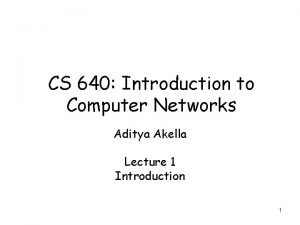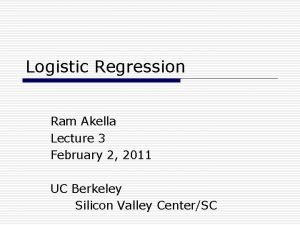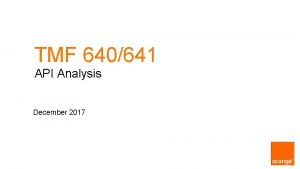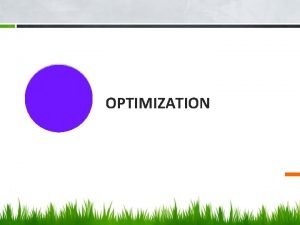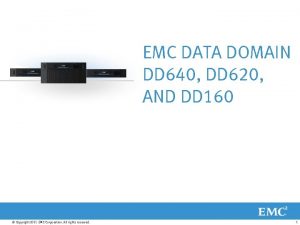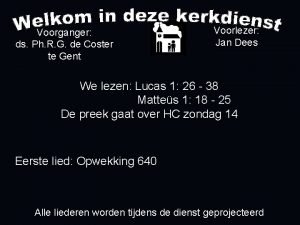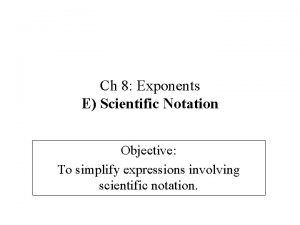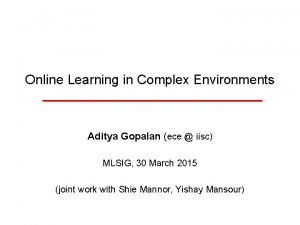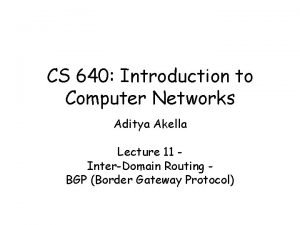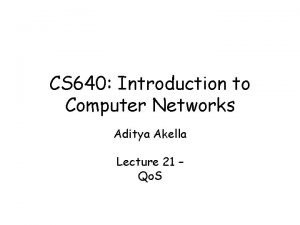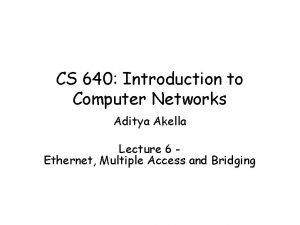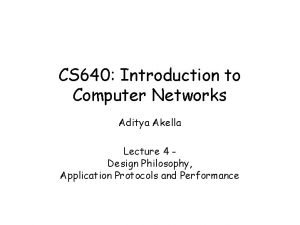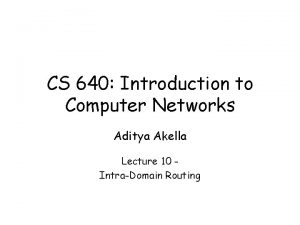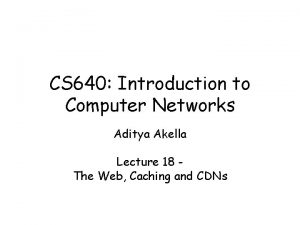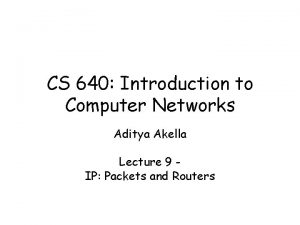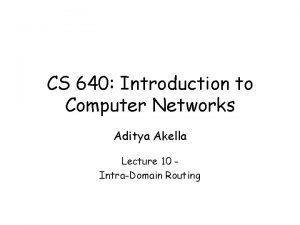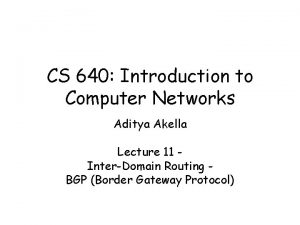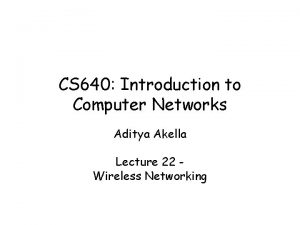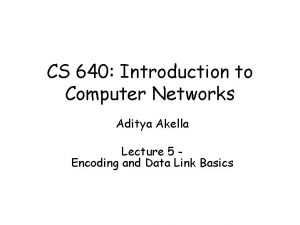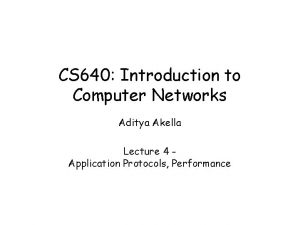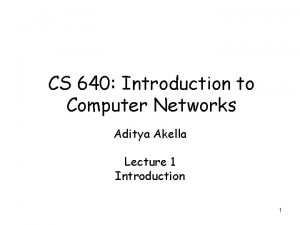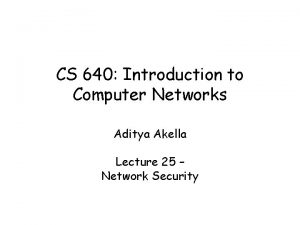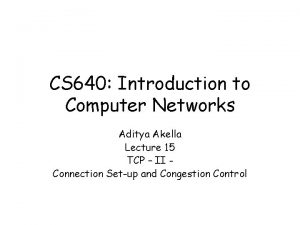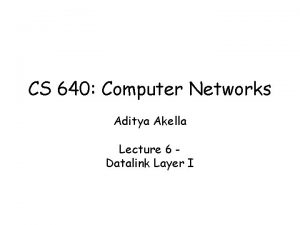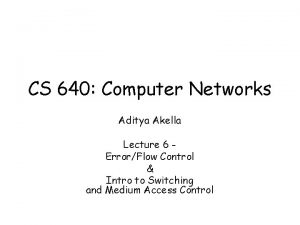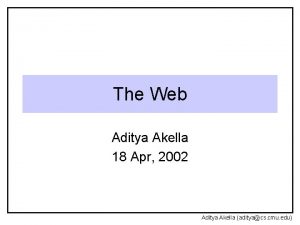CS 640 Introduction to Computer Networks Aditya Akella
























- Slides: 24

CS 640: Introduction to Computer Networks Aditya Akella Lecture 20 – Qo. S

Why a New Service Model? • Best effort clearly insufficient – Some applications need more assurances from the network • What is the basic objective of network design? – Maximize total bandwidth? Minimize latency? – Maximize user satisfaction – the total utility given to users • What does utility vs. bandwidth look like? – Must be non-decreasing function – Shape depends on application 2

Utility curve – Elastic traffic U Elastic Bandwidth Does equal allocation of bandwidth maximize total utility? 3

Admission Control • If U(bandwidth) is concave elastic applications – Incremental utility is decreasing with increasing bandwidth – Is always advantageous to have more flows with lower bandwidth U Elastic BW • No need of admission control and explicit Qo. S mechanisms 4

Utility Curves – Inelastic traffic U Delay-adaptive BW U Hard real-time BW Does equal allocation of bandwidth maximize total utility? 5

Qo. S and Admission Control • If U is convex inelastic applications – U(number of flows) is no longer monotonically increasing • Need admission control and special Qo. S mechanisms U Delay-adaptive BW – Admission control deciding when the addition of new people would result in reduction of utility 6

Qo. S Instantiation #1: Integrated Services Key components: 1. Type of commitment What does the network promise? 2. Packet scheduling How does the network meet promises? 3. Service interface How does the application describe what it wants? 7

Type of Commitments • Guaranteed service – For hard real-time applications – Fixed guarantee, network meets commitment as long as rates clients send at match traffic agreement • Predicted service – For tolerant (e. g. delay-adaptive) applications – Two components • If conditions do not change, commit to current service • If conditions change, take steps to deliver consistent performance (help apps minimize playback delay). Ensure that such apps continue to see a lightly loaded network. • Datagram/best effort service 8

Scheduling for Guaranteed Traffic • Use token bucket filter to characterize traffic – Described by rate r and bucket depth b – Flow. Spec or flow specification • Use Weighted Fair-Queueing at the routers • Parekh’s bound for worst case queuing delay = b/r 9

Token Bucket Filter Tokens enter bucket at rate r Overflow Tokens Bucket depth b: capacity of bucket Packet Enough tokens packet goes through, tokens removed Tokens Packet Not enough tokens wait for tokens to accumulate 10

Token Bucket Characteristics • On the long run, rate is limited to r • On the short run, a burst of size b can be sent • Amount of traffic entering at interval T is bounded by: – Traffic = b + r*T 11

Token Bucket Specs BW 2 Flow B Flow A: r = 1 MBps, B=1 byte 1 Flow A 1 2 3 Flow B: r = 1 MBps, B=1 MB Time 12

Guarantee Proven by Parekh • Given: – Flow i shaped with token bucket and leaky bucket rate control (depth b and rate r) – Network nodes do WFQ • Cumulative queuing delay Di suffered by flow i has upper bound – Di < b/r 13

Putting It All Together • Assume 3 types of traffic: guaranteed, predictive, best-effort • Scheduling: use WFQ in routers • Each guaranteed flow gets its own queue • All predicted service flows and best effort aggregates in single separate priority queue – Predictive traffic classes • Worst case delay for classes separated by order of magnitude • Strict priority queueing – coupled with admission control into each priority level • Higher priority steals scheduling cycles from lower priority One way isolation – Best effort traffic acts as lowest priority class 14

Resource Reservation Protocol (RSVP) • Carries resource requests all the way through the network • Main goal: establish “state” in each of the routers so they “know” how they should treat flows. A C – State = packet classifier parameters, bandwidth reservation, . . • At each hop consults admission control and sets up reservation. Informs requester if failure • Key properties – Receiver driven – Soft state D B • Periodically refresh reservations 15

PATH Messages • PATH messages carry sender’s flow properties • Routers note the direction PATH messages arrived and set up reverse path to sender • Receivers send RESV messages that follow reverse path and setup reservations • If reservation cannot be made, user gets an error 16

RESV Messages • Forwarded via reverse path of PATH • Queuing delay and bandwidth requirements • Source traffic characteristics (from PATH) • Filter specification – Which transmissions can use the reserved resources • Router performs admission control and reserves resources – If request rejected, send error message 17

Differentiated Services: Motivation and Design • Edge routers do coarse grain enforcement – Label packets with a type field Classification and conditioning • Uses IP TOS bits • E. g. a priority stamp • Core routers process packets based on packet marking • More scalable than Int. Serv – No signaling – No per-flow state in the core – More useful between a pair of neighboring networks, while Int. Serv was end-to-end – Typically used by multi-campus enterprises with all campuses connected to the same ISP 18

Diff. Serv Example Sign a service level agreement with ISP. (SLA) Company A Premium packet flow restricted to R bytes/sec Packets in premium flows have bit set internal router host first hop router ISP edge router Unmarked packet flow Set bits appropriately edge router Check if bits conform 19

Expedited Forwarding User sends within agreed profile & network commits to delivery with requested profile – Strong guarantee – User cannot exceed profile packets will get dropped • Core router Simple forwarding: if packet marked as EF, put in priority queue – EF packets are forwarded with minimal delay and loss (up to the capacity of the router) 20

Assured Forwarding • AF defines 4 classes – Strong assurance for traffic within profile & allow source to exceed profile • Implement services that differ relative to each other (e. g. , gold service, silver service…) – Within each class, there at least two drop priorities • Traffic unlikely to be dropped if user maintains profile • User and network agree to some traffic profile – Edges mark packets up to allowed rate as “in-profile” or high priority – Other packets are marked with lower “out-of-profile” priority – A congested router drops lower priority packets with a lot higher probability • Implemented using RED based priority queuing 21

Traffic Conditioning: At Customer Edge AF traffic (two classes) No token Packet input Test if token Packet output Set AF “in” bit EF traffic Drop on overflow Packet input Wait for token Set EF bit Packet output 22

Edge Router Policing: At ISP Edge AF “in” set Arriving packet Is packet marked? Token available? no Clear “in” bit Forwarding engine Not marked EF set Token available? no Drop packet 23

Router Output Processing Strict high priority used What type? EF High-priority Q AF Packets out Low-priority Q with priority drop 24
 Aditya akella
Aditya akella Datagram switching
Datagram switching Backbone networks in computer networks
Backbone networks in computer networks Ram akella
Ram akella Liberate cadence
Liberate cadence Tmf640
Tmf640 Sybex ccna
Sybex ccna A deli sells 640 sandwiches
A deli sells 640 sandwiches Dd160 emc
Dd160 emc 640 800
640 800 Log 640
Log 640 Ccna voice 640-461 pdf
Ccna voice 640-461 pdf Gezang 123
Gezang 123 Stage 2 whole number
Stage 2 whole number 115 hangi yüzlüğe yuvarlanır
115 hangi yüzlüğe yuvarlanır Hino 640
Hino 640 Zvi margaliot
Zvi margaliot Sybex ccna
Sybex ccna 640 000 in scientific notation
640 000 in scientific notation A 640 n hunter gets a rope
A 640 n hunter gets a rope 01:640:244 lecture notes - lecture 15: plat, idah, farad
01:640:244 lecture notes - lecture 15: plat, idah, farad Yadravkar wada
Yadravkar wada Aditya gopalan
Aditya gopalan Pranava mudra
Pranava mudra Aditya parameswaran
Aditya parameswaran
